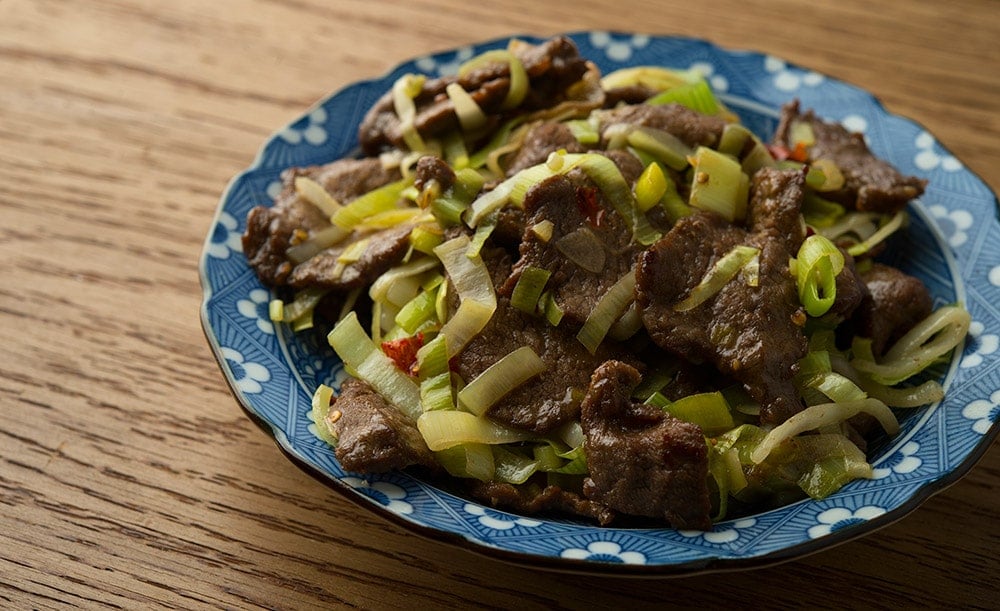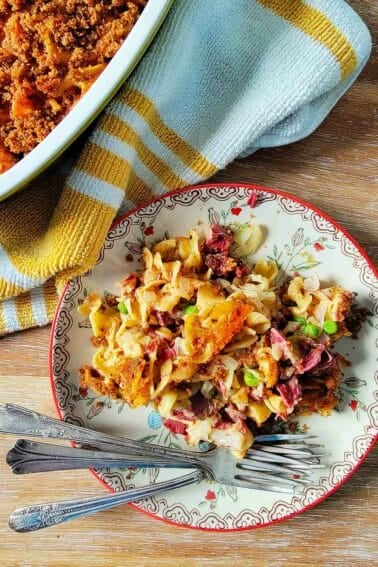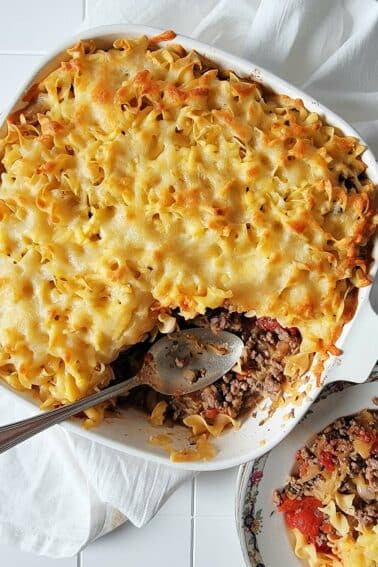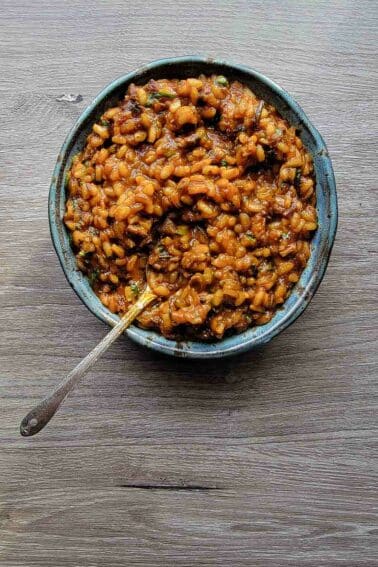As an Amazon Associate I earn from qualifying purchases.

Chinese and “cumin” doesn’t compute to most people. Me included. So when I first saw a dish on my local Sichuan restaurant’s menu called “Cumin Lamb with Leeks,” I had to try it out of sheer curiosity. It has become one of my favorite dishes at this restaurant, almost as good as their twice-cooked pork belly, which I have recreated here.
Lamb is an oddity in Chinese cooking, too, if you are only used to typical American Chinese fare. Trying to get to the bottom of this, I contacted my friend Kian Lam Kho, author of the Red Cook Blog and my favorite Chinese cookbook, Phoenix Claws and Jade Trees: Essential Techniques of Authentic Chinese Cooking.
This is from Kian:
Historically, lamb or goat were not a major part of the Han Chinese diet. Lamb was introduced through the Silk Road into Xinjiang, the northwestern province of China, and serves as the dominant protein of the Muslin Uighur population there. The introduction of lamb was accompanied by cumin, which became the spice of choice by western and northern Chinese cooks to counter the meat’s gaminess. This is why lamb is pretty much always cooked with cumin in the west and the north, whether it is braised, boiled, grilled or stir-fried. Still, around the Mongolian and Beijing regions lamb is often cooked, or poached, in hot pot and served with sesame paste and condiments of chives, and other aromatics. Although lamb has spread throughout most part of China, goat is more common in the southern part of the country.
Always great to have a friend who is a scholar of Chinese food around.
As it happens, Kian has a version of northern Chinese lamb with cumin in his Phoenix Claws and Jade Trees, and this recipe is, for the most part, his. I’ve upped the cumin in it to reflect what my local Sichuan place makes, and I use venison instead of lamb. The result is eye-opening.
When you eat this dish, you get a hit of “not beef” flavor from the venison or lamb, followed closely by the unmistakable warmth of cumin, which will confuse you, because everything else on the plate is most definitely Chinese — the combination of ginger, garlic and chile, plus the soy in the meat marinade set this dish firmly in China.

I happen to love this combination, and it is one of the best Chinese dishes I’ve come across that actually highlights the flavor of venison, rather than simply using venison as a stand-in for beef.
This of course is fine, and I love my kung pao venison, but if they still hunt deer in China it would be where this recipe comes from, and the marriage seems to work naturally.
What’s more, it’s dead easy to make, and requires nothing you can’t get at a typical supermarket.
Chinese Venison with Cumin and Leeks
Ingredients
MARINADE
- 1 tablespoon vegetable oil
- 2 tablespoons soy sauce
- 1 tablespoon corn, potato or tapioca starch
- 2 teaspoons sugar
- 2 teaspoons ground cumin
- 1 teaspoon ground white pepper
TO FINISH
- 1 1/4 pound venison backstrap, sliced into 1/8-inch pieces
- 2 cups canola oil
- 2 tablespoons minced garlic
- 6 to 8 very thin slices of ginger
- 2 to 10 small, hot dried chiles, broken up and seeded
- 2 medium leeks, white and light green parts only, sliced thin
- 1 teaspoon salt
- Cilantro for garnish (optional)
Instructions
- Mix all the ingredients for the marinade in a bowl that will hold all the sliced venison. Using your (very clean) hands, massage the marinade into the slices, making sure they separate from each other and get some of the marinade on every slice. Set the bowl in the fridge for 20 minutes while you chop all the other vegetables.
- Bring the 2 cups of canola oil to 375°F to 390°F in a small pot or wok. Set a colander or coarse mesh sieve over a bowl, and get a Chinese spider strainer or slotted spoon, plus a chopstick or butter knife ready. Put about 1/4 of the venison in the hot oil, and use the chopstick to separate the slices as soon as they hit the oil. Let the meat flash fry for 10 to 15 seconds, then use the strainer to move the meat to the colander to drain. Repeat with the rest of the meat, 1/4 at a time. When all the meat has been flash fried, turn off the heat and let the oil cool a bit. You can pour it into a heatproof container, strain it and use it several times before you need to toss it. If you fried in a wok, leave about 2 to 3 tablespoons of the oil in the wok. If not, put 2 to 3 tablespoons of oil into a large frying pan.
- Heat the oil over high heat until it is almost smoking. Add the garlic, ginger and chiles and stir-fry for 30 seconds. Add the sliced leeks and stir-fry for 1 minute, until they wilt.
- Add the meat back to the wok or pan and stir-fry for another minute, sprinkling the salt over everything as you do this. Turn off the heat and toss in the cilantro,, if you're using it, and serve at once with steamed rice.
Nutrition
Nutrition information is automatically calculated, so should only be used as an approximation.





Hi Hank!
I have some pressure cooker canned antelope. Do you think this recipe would fair well with it? What suggestions would you have for adjusting the marinade? Thank you so much for your help.
Sandy: No, I don’t think so. That’s already soft and cooked, and this is a hot and fast recipe.
This is what I’m searching for! My 13 year old killed his first whitetail last Sunday and loves my srir fry rice and Kong Pow chicken. Im trying to teach him all I know about cooking venison from shot to pan, thank you sir.
Thank you for posting this up for free. Are the velveting temps 100 deg.. to high, typo?
Steve: No, because this is not velveting. You want the venison to be almost crispy-chewy, so you want that high heat. It’s a wester Chinese recipe. Canton is the home of that classic, low temp velveting.
Fantastic, I used deer backstrap and marinated for most of the day. My wife said this is now her favourite deer dish, formerly held by Hank’s Bobotie recipe.
Used a skinned mallard breast in a half-recipe and it was delicious and the perfect amount for two people.
This was a great recipe! It came together quickly enough for a weeknight, but was so flavorful it felt like a treat. I added sliced button mushrooms to the pan along with the leeks since I didn’t have quite the quantity of meat called for. I will be coming back to this one.
Absolutely loved this recipe as I have access to all the ingredients in Laos, SE Asia… well all except venison. I substituted water buffalo. It was delicious. Thanks for all the great ideas!
Made this with pronghorn backstrap substituting regular onion for leaks. It was excellent with rice and broccoli.
Made this last week and it was outstanding. I’m going to back off the amount of peppers next time I used 8-10 long slim cayenne’s I had dried from last years garden. But I couldn’t stop eating it. Same thing happens to me with a good Thai curry. Sweat dripping down your face and you can’t stop shoveling. The texture of the meat was fantastic after the flash fry. I forgot how good a piece of venison was fried. When I was a kid we would butcher deer as a family with some cousins and uncles and always had a fondue pot of peanut oil going so when we were hungry we would cut off an hunk and cook it in the oil and eat it off the fork. The original fast food. It Had that same texture. Top notch recipe!
Just made this last night and what a revelation! So tender, subtle, and really, really good. The backstraps were perfect for it.
I usually like to keep the backstraps for something simpler like Florentine style with warm olive oil and herbs, it’s a gourmet cut in my eyes. Think this would work well with any other cut sliced across the grain, shoulder perhaps?
Rob: Definitely not shoulder. Try using meat from the hind legs, which will be “cleaner,” without much sinew.
I made this yesterday with a tenderized elk round-steak, sliced into bite-size pieces. The tenderizing resulted in really crispy bits and a great texture. It also absorbed the marinade really well. Will definitely be making this again.
We made this with onion and bok choy instead of leek. It’s a good thing that backstraps are not a big cut of meat, because we would have just kept eating until we exploded…
Oh, just hell yes. My favorite spice with one of my fave meats. Thanks for this.
Sounds great Hank; does it work well with tags too? I got a little bored with tag soup last year!
Douglas: Tags are best in soup, served with heaping portions of shame, regret and disappointment. And believe me, I’ve learned this through personal experience…
Hank,
Thanks for this recipe. I have a goat neck in the freezer and have been wondering what to do with it. I noticed that Kian mentioned sesame paste by which I assume he means tahini but you didn’t include it in the recipe. So where do you think would be best, in the marinade or in the stir fry?
Ward
London
(Sadly, no longer part of Europe!)
Ward: Sesame doesn’t belong in this recipe. Kian was talking about common pairings of lamb and other flavors in Chinese cuisine in general.